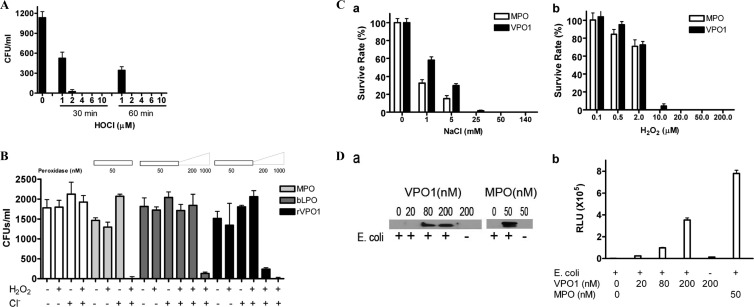Fig 4.
Bactericidal activity of rVPO1. (A) Bactericidal activity of reagent HOCl. E. coli was incubated in 50 mM phosphate buffer (pH 6.2) and the indicated amount of reagent HOCl at 37°C for 30 min and 1 h, respectively. The cell mixture was plated on LB plates. In control experiments, no HOCl was present. The data are from three independent experiments. (B) E. coli was incubated in 50 mM phosphate buffer (pH 6.2) containing 140 mM NaCl, 10 μM H2O2, and the indicated amount of MPO, bLPO, or rVPO1 at 37°C for 1 h. Cell mixtures were plated on LB plates. In control experiments, only H2O2 (10 μM) or Cl− (140 mM) was present. The data are representative of ≥3 independent experiments. Error bars indicate the SD. (C) NaCl- and H2O2-dependent bactericidal activities by VPO1. Experiments were carried out as described for panel B with 200 nM VPO1. In the NaCl dose-dependent experiments (a), H2O2 was maintained at 10 μM and the NaCl concentrations are indicated, whereas in the H2O2-dose dependent experiments (b), NaCl was maintained at 140 mM and the H2O2 concentrations are indicated. MPO at 50 nM was used as a control. (D) VPO1 binds to E. coli. E. coli cells were added into VPO1 or MPO as indicated in 1× PBS (pH 7.4). The mixtures were incubated at 37°C for 1 h. E. coli cells were spun down at 5,000 rpm for 5 min. The cells were washed twice and subjected to immunoblotting with anti-VPO1 or anti-MPO antibody (a) and chemiluminescence assay with L-012 (b).

